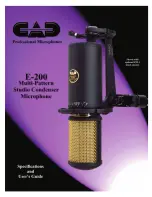
stereo recordings!).
Lastly, our VELO-8’s ribbon is field interchangeable by the user (more on that
groundbreaking feature later).
2. The Magnetics:
The classic RCA 44 ribbon mics were relatively high signal
output devices (as compared with other ribbon mics) which was the result of a
larger element and massive ceramic or Alnico alloy magnets placed around the
ribbon element; more magnetic field gives more output, just like guitar
pickups or speakers. These RCA 44 mics are favorites of engineers both
today and then... and captured early Elvis and Sinatra tracks quite nicely. These
early Capitol tracks were smoother than the later tracks by these same artists,
as they were mostly recorded with more highly-detailed and brighter condenser
mics like the Neumann U47. You will also notice more noise floor on the earli-
er recordings, but who cares? The “feel” of these performances could not have
been captured any other way, and the truth is that both were great recordings,
but for different reasons!
However, today we have a new magnetic material, Neodymium, that is 100
times more powerful than the best of the old Alnico magnetic alloys that RCA
and others used. Also, unlike natural occurring magnets, the new materials can
be cast into special shapes. All previous ribbon mic magnetics, both yesterday
and today, have been made from off shelf square bars placed in a metal
conductor. But instead of using commonly available off shelf magnets, we
designed and custom cast a totally new “roof top” shaped magnet that
concentrates the magnetic field on the edge of the ribbon and increases signal
output. We also used the highest quality aerospace Neodymium material that
costs 20 times more than the common Neodymium magnets you’d find on your
money clips and refrigerator decorations. Furthermore, we choose to use a
“high output roof top” magnet on BOTH sides of the ribbon. Most ribbons
today (and then) have just a single sided magnet that uses a steel chassis to
pass the magnetics to the opposite side of the ribbon element. This was the
most costly approach... but of course, as we are suckers for quality and
performance, we believe it was well worth it, as this approach boosts both
signal output (while lowering the floor noise) and improves detail (with more
depth and frequency response). In short, it simply makes for better recordings.
3. The Transformer:
The transformer’s job is VERY important as it interfaces
the ribbon output to the preamplifier’s input. The ribbon element is typically
very low impedance, just one or two Ohms, and also needs a significant level
boost as well. Therefore, the transformer must boost both the output level and
raise the impedance of the ribbon element, with as little degradation as possible
5
VELO-8 REFERENCE MANUAL


































